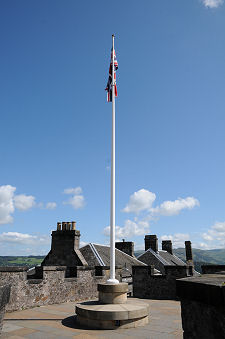 The Forework Gatehouse Today |
Stirling Castle is well defended on three sides by the rock on which it stands. The natural approach to the castle is from the south, from the Esplanade and the centre of the City of Stirling. Because of this the south side of the castle would always have been the most heavily fortified. As early as 1380 there were references to walled defences here together with an entrance protected by a drawbridge. It seems highly likely that this was laid across the castle rock along the line used by James IV for the Forework which remains partially on view today, well within the later Outer Defences.
James IV's grand vision for Stirling Castle started with the construction of the King's Old Building, and culminated with the Great Hall. But he was also responsible for the building of the Forework, a magnificent set of defences guarding the main body of the castle from the south. (Continues below image...)
 The Forework Today, Shown on the Castle Model in the North Gate |
These centred on the Forework Gatehouse. This remains impressive. But as built between 1501 and 1506, the gatehouse and its towers would have been twice as high, with the towers topped off by conical roofs. And rather than the two towers you see today, there would have been six. A matching pair of towers were built on the north side of the gatehouse, in the Outer Close, while two more semi-circular towers were placed on the line of the curtain wall, one to each side of the gatehouse.
The curtain wall of the Forework ended at large rectangular towers. One of these, the Prince's Tower, still stands to almost its original height, though it was later incorporated into the design of the Palace. At the eastern end of the line of the Forework it is still possible to see the base of the second tower, the Elphinstone Tower, beyond the Unicorn Café and behind the French Spur.
Imagine this series of high walls and even higher towers, and then imagine them coated in the bright limewash with which the Great Hall has been restored. The result would have been visible from miles around, as the Great Hall is today, and truly awe-inspiring. Which was probably what James IV had in mind. It has been suggested that the Forework was rather out of date as a purely defensive structure even when built: and that what James IV was really trying to do was recreate some sort of idealised medieval castle.
James V's great addition to the castle, the Palace, was fitted in behind the west side of the Forework in about 1540 in a way that would have added still further to the visual impact of the castle.
Later changes did the Forework fewer favours. In August 1650 the Gatehouse was badly damaged during the siege by General Monck (see our Stirling Castle Timeline).
In 1689 the Elphinstone Tower, at the east end of the Forework, was cut down to the stump you see today to provide the base for an artillery battery and filled in. The remains of the Elphinstone Tower were cleared out and made safe in 1982 and the lowest two storeys are now accessible from the Outer Close.
At some point, probably during the defensive improvements undertaken between 1711 and 1714, more changes were made. The semi circular towers on the Forework curtain wall were removed, though the base of one and the outline of the stonework of the other is still visible.
And at the same time the gatehouse and remaining towers were significantly lowered in height and the two towers on the inner side of the gatehouse were removed: though again traces of where these connected to the gatehouse can still be seen.
 Another View of the Forework Gatehouse |

|
|
|
Visitor InformationView Location on MapFull information can be found on our Stirling Castle Main Page. What3Words Location: ///secret.branch.bats |
Stirling Castle In Fiction
|
 Flag Pole |
 Base of the West Semi-Circular Tower |
 Elphinstone Tower Interior |
 Hide and Seek by Ken Lussey (26 May 2023).
Hide and Seek by Ken Lussey (26 May 2023).



